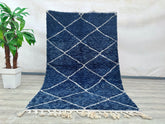Discover the Beauty and History of Moroccan Rugs
What Makes Moroccan Carpets Unique?
One thing that makes Moroccan rugs special is how they are the epitome of tradition and modernity. Over centuries, these hand knotted rugs have become a staple in the Moroccan culture & were more than just floor furnishings. Rugs are frequently placed on walls or for prayers and feature detail patterns, bright colors, fine workmanship. Classical and artistic, these rugs are rich in meticulous crafts and solid cultural heritage that make them a perfect piece for all interiors.
The Interesting History Of Moroccan Rug
Moroccan rugs have been in existence since the 15th-century when Morocco was a thriving trading hub. Rugs with minimalistic designs were made by the Berber people, who are weavers, for practical use cases like securing warmth and protecting the floor. It grew and evolved over time into the complex, sprawling designs we have today.
The 17th and 18th centuries were not content with simpler patterns, however, engaged in the appearance of more complex ones on Moroccan rugs. Legacy for their artistry and craftsmanship was celebrated in the 19th century.
Types of Moroccan rugs
Moroccan rugs have different styles that represent motifs and symbols, causing each rug to be unique in its own way. They included some of the most highly desired styles, like:
Berber Rugs
Berber rugs, as made by the native Berber tribes are famous for their simple geometric patterns. Crafted from natural wool, theses are earthy with soft colors that add a rugged handmade touch to any room.
The Beni Ourain reads are from the same tribe that creates Moroccan Berber rugs in modern and minimal patterns. Beni Ourain rugs, made from sheep wool and characterized by black or brown patterns on a white or cream background offer a timeless appeal.
Bright and eclectic, Boucherouite rugs are made from recycled materials such as old clothes. Featuring bright colors and vivid, geometric patterns to work well in bold, statement-making spaces
Kilim rugs are made in a way which weavers use flat-weave technique. They are recognized for their bold, angular forms and bright hues that can deliver a powerful punch to any area.
Moroccan Rugs - Patterns and Decorative Elements
More than just visually beautiful, Moroccan rugs carry a lot of cultural symbolism. Every pattern has, after all, a narrative message posted on every single point according to the route of the fabric is woven. Common motifs include:
Stars: The sky's endlessness, Luck
Diamond — Represents abundance and prosperity.
Flowers- symbolism of the nature and life
Animals — Horses and camels are the commonly used figures of animals that represent strength and vitality.
Uses of Moroccan Rugs
They are versatile and not only a piece for everyday use but can be used as decoratives too. Here are some of the common use cases for these functions:
Floor Covering: They are perfect for the floor, they give a soft and strong surface to the containers and also offer coziness.
Wall Accessories: Morroccan rugs are also used as the wall cover adding texture, color, and pattern to a room.
Decorative Accents: Moroccan rugs are also great for decorating elements to your home — they will bring in an aesthetic appearance to the interior of your house.
Conclusion
Moroccan rugs are more than just beautiful floor coverings, Every rug is a piece of art that tells tales about the Moroccan history and culture. Weaving bright, bold designs and intricate patterns with a soft touch of individuality and functional art into your everyday life — these woven treasures make a real impression as floor decor, wall hangings or top the guest bed as an accent. Berber rug layers or kilim´s colors: does not matter, the Moroccan rugs always provide elegance and a refined touch to any room.
Featured Products
169 x 251 cm = 5.5 x 8.2 ft moroccan wool rug, moroccan style rug, bohemian rug, handmade rug, outdoor patio, beniourain Rug, decor rug, Handmade Gift
- $599.00
$1,830.00- $599.00
- (-67%)
- Unit price
- / per
155 x 247 cm = 5.1 x 8.1 ft Diamonds Blue Soft Dots Berber Runner Rug - Handmade Moroccan Wool, Minimalist Design, Vintage Style, Perfect for Weddings & Bohemian Decor
- $599.00
$1,830.00- $599.00
- (-67%)
- Unit price
- / per
- Beni Ourain
- Beni Rugs
- Berber rug
- Berber rug history
- Berber tribes
- Custom Area Rug
- Custom Beni Ourain Rug
- Custom Moroccan Rugs
- Hand-woven rugs
- Handmade rug imperfections
- Modern Beni rugs
- Moroccan Berber rug
- Moroccan heritage
- Moroccan home décor
- Moroccan rug authenticity
- Moroccan rug buying guide
- Natural fiber rugs
- Neutral hue rugs
- Rug craftsmanship
- Rug interior alignment
- soft moroccan rug
- Timeless rug designs
- Vintage Moroccan Rug
- warm rug
- White wool rug










